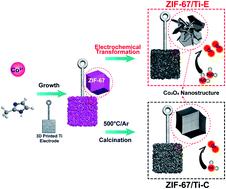当前位置:
X-MOL 学术
›
Sustain. Energy Fuels
›
论文详情
Our official English website, www.x-mol.net, welcomes your feedback! (Note: you will need to create a separate account there.)
Metal–organic-frameworks on 3D-printed electrodes: in situ electrochemical transformation towards the oxygen evolution reaction
Sustainable Energy & Fuels ( IF 5.6 ) Pub Date : 2020-05-27 , DOI: 10.1039/d0se00503g Yulong Ying 1, 2, 3, 4, 5 , Michelle Philippa Browne 1, 2, 3, 4, 5 , Martin Pumera 1, 2, 3, 4, 5
Sustainable Energy & Fuels ( IF 5.6 ) Pub Date : 2020-05-27 , DOI: 10.1039/d0se00503g Yulong Ying 1, 2, 3, 4, 5 , Michelle Philippa Browne 1, 2, 3, 4, 5 , Martin Pumera 1, 2, 3, 4, 5
Affiliation

|
Metal–organic framework (MOF) derived materials are important alternatives for electrochemical energy storage and conversion, due to their highly large surface area, abundant active sites, and diversity in composition and structure. In this work, a controllable electrochemical transformation of ZIF-67 into active porous metal oxides is employed for the oxygen evolution reaction (OER). ZIF-67 is directly coated onto the surface of three-dimensional (3D) printed titanium (Ti) electrodes using a step-by-step in situ growth and then converted into cobalt oxide (Co3O4) by electrochemical cycling, designated as ZIF-67/Ti-E electrode. Raman spectroscopy, scanning electron microscopy (SEM), and cyclic voltammetry (CV) have been used to verify the electrochemical transformation from octahedral ZIF-67 to thin sheet-shaped Co3O4. This large-surface-area Co3O4, as well as the existence of CoIV species right before water oxidation, plays a critical role in enhanced OER performance under alkaline electrolysis conditions. The optimized ZIF-67/Ti-E electrode has demonstrated a better OER performance with a low overpotential of 360 mV at a current density of 10 mA cm−2 and excellent durability, compared with its counterparts produced by the widely popular calcination method. Our method provides a simple in situ, fast, mild, and energy-efficient approach to employ MOF-derived materials as promising OER catalysts using scaled-up 3D-printed electrodes.
中文翻译:

3D打印电极上的金属有机框架:向氧气释放反应的原位电化学转变
金属-有机骨架(MOF)衍生的材料由于具有很大的表面积,丰富的活性位点以及组成和结构的多样性,因此是电化学能量存储和转换的重要替代方法。在这项工作中,ZIF-67的可控电化学转化为活性多孔金属氧化物被用于氧释放反应(OER)。使用分步原位生长将ZIF-67直接涂覆到三维(3D)打印的钛(Ti)电极的表面上,然后转化为氧化钴(Co 3 O 4通过电化学循环,称为ZIF-67 / Ti-E电极。拉曼光谱法,扫描电子显微镜(SEM)和循环伏安法(CV)已用于验证从八面体ZIF-67到薄片状Co 3 O 4的电化学转变。这种大表面积的Co 3 O 4以及在水氧化之前就存在Co IV物种,在碱性电解条件下增强OER性能方面起着至关重要的作用。经过优化的ZIF-67 / Ti-E电极在10 mA cm -2的电流密度下具有360 mV的低过电势,具有更好的OER性能。与通过广泛流行的煅烧方法生产的同类产品相比,具有极好的耐久性。我们的方法提供了一种简单的原位,快速,温和且节能的方法,可使用按比例放大的3D打印电极将MOF衍生的材料用作有前途的OER催化剂。
更新日期:2020-06-30
中文翻译:

3D打印电极上的金属有机框架:向氧气释放反应的原位电化学转变
金属-有机骨架(MOF)衍生的材料由于具有很大的表面积,丰富的活性位点以及组成和结构的多样性,因此是电化学能量存储和转换的重要替代方法。在这项工作中,ZIF-67的可控电化学转化为活性多孔金属氧化物被用于氧释放反应(OER)。使用分步原位生长将ZIF-67直接涂覆到三维(3D)打印的钛(Ti)电极的表面上,然后转化为氧化钴(Co 3 O 4通过电化学循环,称为ZIF-67 / Ti-E电极。拉曼光谱法,扫描电子显微镜(SEM)和循环伏安法(CV)已用于验证从八面体ZIF-67到薄片状Co 3 O 4的电化学转变。这种大表面积的Co 3 O 4以及在水氧化之前就存在Co IV物种,在碱性电解条件下增强OER性能方面起着至关重要的作用。经过优化的ZIF-67 / Ti-E电极在10 mA cm -2的电流密度下具有360 mV的低过电势,具有更好的OER性能。与通过广泛流行的煅烧方法生产的同类产品相比,具有极好的耐久性。我们的方法提供了一种简单的原位,快速,温和且节能的方法,可使用按比例放大的3D打印电极将MOF衍生的材料用作有前途的OER催化剂。


























 京公网安备 11010802027423号
京公网安备 11010802027423号